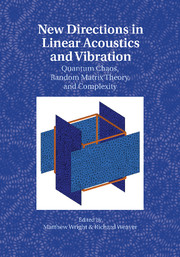Book contents
- Frontmatter
- Contents
- Foreword by Michael Berry
- Introduction
- 1 The Semiclassical Trace Formula
- 2 Wave Chaos for the Helmholtz Equation
- 3 The Unreasonable Effectiveness of Random Matrix Theory for the Vibrations and Acoustics of Complex Structures
- 4 Gaussian Random Wavefields and the Ergodic Mode Hypothesis
- 5 Short Periodic Orbit Theory of Eigenfunctions
- 6 Chaotic Wave Scattering
- 7 Transfer Operators Applied to Elastic Plate Vibrations
- 8 Mesoscopics in Acoustics
- 9 Diagrammatic Methods in Multiple Scattering
- 10 Time-Reversed Waves in Complex Media
- 11 Ocean Acoustics: A Novel Laboratory for Wave Chaos
- 12 Mesoscopic Seismic Waves
- 13 Random Matrices in Structural Acoustics
- 14 The Analysis of Random Built-Up Engineering Systems
- References
- Index
14 - The Analysis of Random Built-Up Engineering Systems
Published online by Cambridge University Press: 05 October 2010
- Frontmatter
- Contents
- Foreword by Michael Berry
- Introduction
- 1 The Semiclassical Trace Formula
- 2 Wave Chaos for the Helmholtz Equation
- 3 The Unreasonable Effectiveness of Random Matrix Theory for the Vibrations and Acoustics of Complex Structures
- 4 Gaussian Random Wavefields and the Ergodic Mode Hypothesis
- 5 Short Periodic Orbit Theory of Eigenfunctions
- 6 Chaotic Wave Scattering
- 7 Transfer Operators Applied to Elastic Plate Vibrations
- 8 Mesoscopics in Acoustics
- 9 Diagrammatic Methods in Multiple Scattering
- 10 Time-Reversed Waves in Complex Media
- 11 Ocean Acoustics: A Novel Laboratory for Wave Chaos
- 12 Mesoscopic Seismic Waves
- 13 Random Matrices in Structural Acoustics
- 14 The Analysis of Random Built-Up Engineering Systems
- References
- Index
Summary
Introduction
There has been much recent interest in predicting the response of structures that have uncertain or random properties, and this is particularly true in the field of vibroacoustics. In predicting interior or radiated noise a broad frequency range is of interest, and the response of an engineering structure such as a car or an airplane can be highly sensitive to small manufacturing variations, particularly at higher frequencies. Ideally this sensitivity should be identified and quantified at the design stage, so that the performance of the complete set of produced articles can be predicted, rather than just the performance of a nominally perfect design. Perhaps the most direct way to consider the effect of system uncertainty on the response is to adopt a parametric model. This approach consists of (i) identifying the uncertainties in the key physical properties (or “parameters”) of the system, and (ii) propagating this uncertainty through the governing equations of motion to predict the uncertainty in the response. However both parts of this procedure can present severe practical difficulties. With regard to issue (i), the parametric model would ideally consist of the detailed statistical distribution of the system properties (material properties, dimensions, rigidity of joints, etc.), but it can be extremely difficult to acquire this data or even to identify which of the system properties are statistically significant. This problem can be overcome to some extent by adopting a less precise parametric model of the system uncertainties, consisting of perhaps bounds (Elishakoff 1995) or fuzzy-number descriptions (Moens & Vandepitte 2005), but the difficulty of propagating this uncertainty through the equations of motion, issue (ii), still remains.
Information
- Type
- Chapter
- Information
- New Directions in Linear Acoustics and VibrationQuantum Chaos, Random Matrix Theory and Complexity, pp. 231 - 250Publisher: Cambridge University PressPrint publication year: 2010
Accessibility standard: Unknown
- 1
- Cited by
